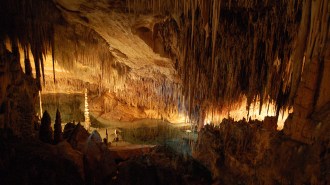Earth
Sign up for our newsletter
We summarize the week's scientific breakthroughs every Thursday.
-
 Earth
EarthMagnitude 7.8 earthquake hits Iran
Casualties reported in nearby Pakistan from temblor.
By Erin Wayman -
 Earth
EarthGeologists develop weapons to combat that sinkhole feeling
What do five Porsches, several Kentucky thoroughbreds and a three-story building in Guatemala City have in common? They’ve all been swallowed by sinkholes. Sadly, the sudden cave-ins sometimes claim people’s lives as well. On February 28 the earth opened up underneath the Seffner, Fla., bedroom of Jeff Bush, entombing him. The freak accident highlighted Florida’s […]
-

-
 Climate
ClimateCuts in some greenhouse gases could slow sea level rise
Methane, ozone and other short-lived pollutants have a big impact on ocean heights, simulation finds.
By Erin Wayman -

-
 Climate
ClimateRising carbon dioxide means more air turbulence
More jarring flights are likely, simulation suggests.
By Erin Wayman -
 Earth
EarthIsolated coral reefs can regrow after bleaching
Having neighboring coral reefs is unnecessary for recovery.
By Meghan Rosen -
 Earth
EarthHow the West was done
The tectonic history of North America’s Pacific Rim gets even more jumbled.
By Erin Wayman -
 Earth
EarthIn Antarctica, melting may beget ice
Disintegration of floating glaciers could be responsible for freezing of seawater.
By Erin Wayman -
 Earth
EarthFungi pull carbon into northern forest soils
Organisms living on tree roots do the lion’s share of sequestering carbon.
By Meghan Rosen -
 Animals
AnimalsTermites, not fairies, cause plant circles in African deserts
Underground insect engineers create water traps in the soil, allowing rings of green grasses in the sand.
By Susan Milius -
 Earth
EarthKansas was unbearably hot 270 million years ago
Temperatures soared to nearly 74 degrees Celsius, which no plants or animals could endure.
By Erin Wayman